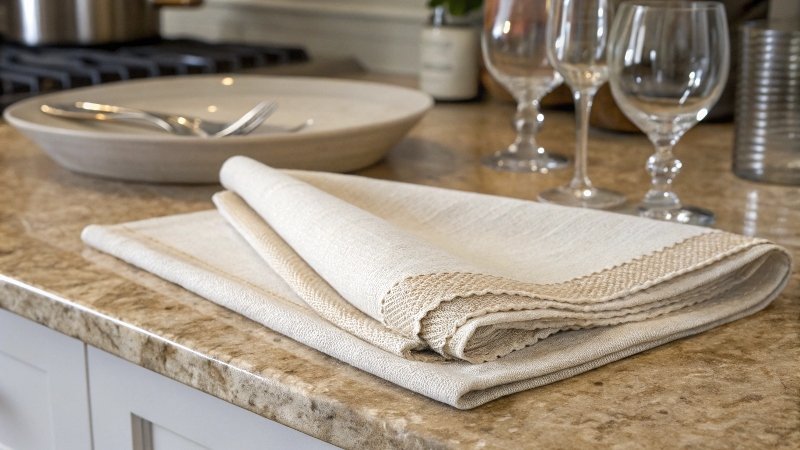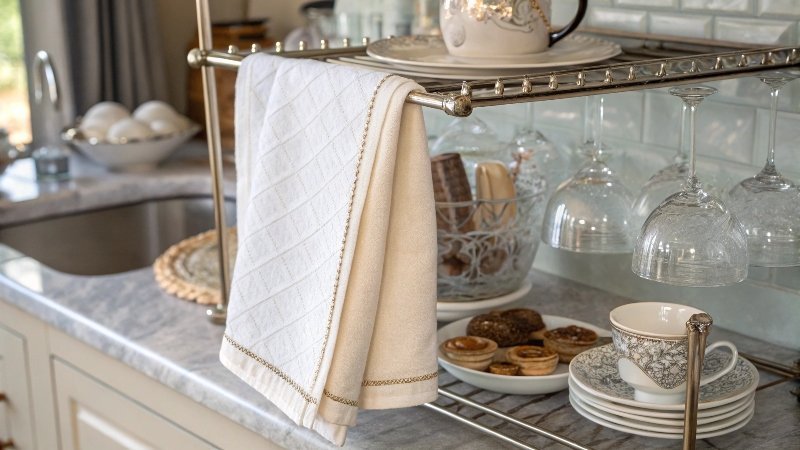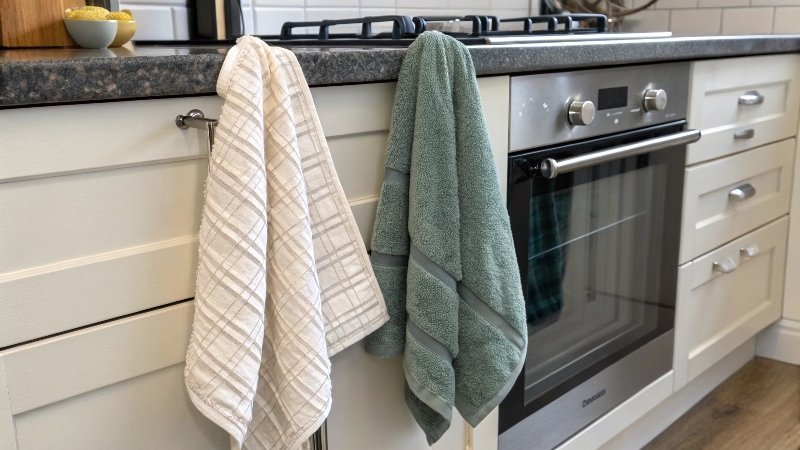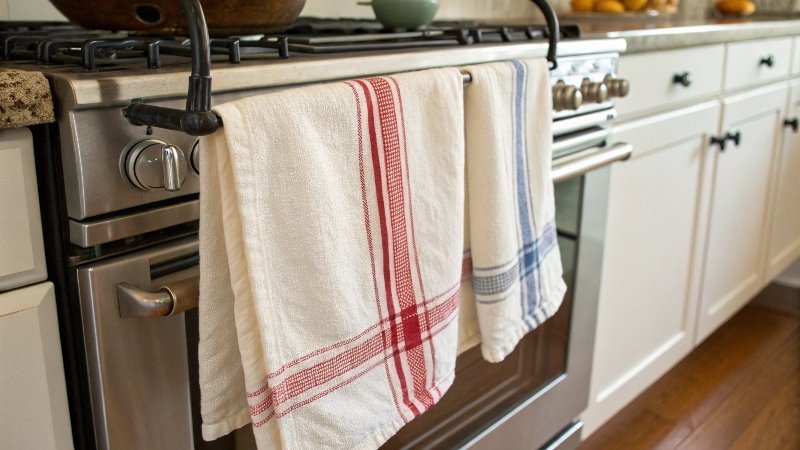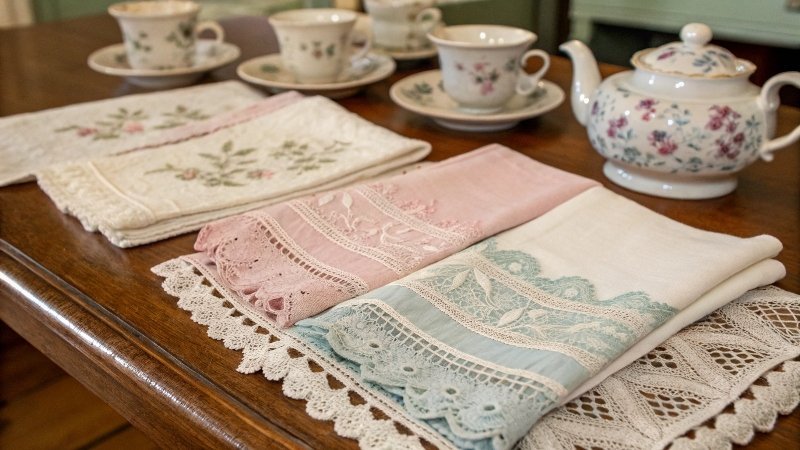Confused about what makes a tea towel special? You’re not alone. This simple kitchen item is often misunderstood, leading to the wrong choice for your brand or home.
A tea towel is a smooth, lint-free cloth, usually made of linen or flat-weave cotton. Its primary job is to dry delicate items like glassware and cutlery without leaving behind fluff, but it also serves as a popular decorative kitchen accent.
That’s the short answer, but there’s so much more to it. For anyone looking to source, sell, or simply use the right towel for the job, understanding the details is key. We’ve been making towels since 2004, and I’ve seen firsthand how a small thing like choosing the right towel can make a big difference for a brand. Let’s break it down and clear up the confusion for good.
What is the point of a tea towel?
Think a tea towel is just a pretty kitchen accessory? Many people miss its practical uses, overlooking a versatile tool that can elevate everyday tasks and impress customers.
The main point of a tea towel is its lint-free drying ability, making it perfect for polishing delicate china, glassware, and silver. It’s also used for covering food, lining serving trays, and as a decorative kitchen textile.
When we work with new clients, especially in the hospitality or gift sectors, I always emphasize that a tea towel is a multi-purpose tool. Its value goes far beyond just looking good hanging on an oven door. Thinking about its core functions helps you market it effectively.
Functional Uses
A tea towel’s construction is what defines its purpose. Unlike a fluffy bath or kitchen towel, it’s typically made from a flat weave. This tight construction is the secret to its lint-free performance. Here are its main jobs:
- Polishing and Drying: This is its original and most important role. I remember a boutique hotel client who was frustrated with their bar staff using standard terry towels on wine glasses. They were leaving tiny fibers behind. We switched them to a tight-weave cotton tea towel, and the problem was solved instantly. The glasses were sparkling, and the bartenders were happier.
- Food Handling: A clean tea towel is invaluable in the kitchen. You can use it to cover a bowl of rising bread dough, wrap warm scones to keep them soft, or line a serving basket. We once created a set of custom-printed tea towels for a bakery. They included one in every gift basket, turning a simple utility item into a memorable part of their brand experience.
Decorative Appeal
Don’t underestimate the power of a tea towel as a design piece. Because of its flat surface, it’s the perfect canvas for printing. Brands use them for everything from seasonal collections and botanical prints to bold logos and quirky sayings. They are an affordable way for a customer to add personality to their kitchen, making them a fantastic product for direct-to-consumer brands and gift shops.
What is the difference between a tea towel and a kitchen towel?
Is a tea towel just a fancy name for a kitchen towel? This common mix-up can lead to sourcing the wrong product and disappointing your customers with a towel that doesn’t perform as expected.
A tea towel is thin, smooth, and made for polishing without lint. A kitchen towel (or dish towel) is typically thick and absorbent, with a looped terry pile designed for soaking up spills and general cleaning.
I’ve had many conversations with Amazon sellers who accidentally used these terms interchangeably. The result was negative reviews from customers who bought a "tea towel" to dry a big spill and found it wasn’t absorbent enough, or bought a "kitchen towel" and were angry it left lint on their wine glasses. Being precise with your language is crucial for e-commerce success. Clarity avoids returns and builds trust.
To make it simple, here is a direct comparison:
| Feature | Tea Towel | Kitchen Towel (Terry) |
|---|---|---|
| Primary Use | Polishing glass, drying cutlery, decorative | Soaking up spills, drying hands, heavy-duty cleaning |
| Material | Linen, flat-weave cotton, flour sack | Terry cloth cotton, microfiber |
| Texture | Smooth, flat, non-abrasive | Looped pile, plush, absorbent |
| Lint Factor | Very low to none | Can leave lint, especially on glass |
| Drying Speed | Dries very quickly | Dries slowly due to thickness |
The key takeaway is the texture. A tea towel’s flat weave ensures no fibers are left behind. A kitchen towel’s terry loops are designed to grab and hold as much water as possible, which also means they can snag on delicate items and leave lint. You wouldn’t use sandpaper to wash a car, and you shouldn’t use a terry towel to polish your best glasses. They are two different tools for two different jobs. When we advise clients, we tell them to think about the end-user’s main problem: are they polishing or are they cleaning up a mess? The answer determines which towel they need to source.
What do Americans call tea towels?
Selling to the US market from abroad? Calling a product a "tea towel" might confuse some American buyers, causing your beautifully designed product to get lost in search results or overlooked.
In the United States, a tea towel is most commonly called a "dish towel." The term "flour sack towel" is also widely used for a similar style. While "tea towel" is understood, it’s often seen as decorative or more traditional.
Language is one of the biggest hurdles I see for international brands entering the US market. The wrong keyword can make you invisible. At TowelTrend, we guide our North American clients on how to label their products for maximum visibility. It’s not just about the product; it’s about how people search for it.
Let’s break down the American terminology:
Dish Towel
This is the most common and broad term in the US. The problem is, it’s a catch-all. An American might use "dish towel" to describe a lint-free polishing towel or a thick terry cleaning towel. For an online seller, this is a challenge. My advice is to be more specific in your product titles and descriptions. For example, use "Lint-Free Cotton Dish Towel for Glassware" or "Absorbent Terry Dish Towel for Spills." This helps the customer know exactly what they’re getting.
Flour Sack Towel
This term refers to a specific type of large, thin, highly absorbent cotton towel that is very similar to a traditional tea towel. They get their name from their history, as they were literally repurposed from the cotton sacks used for flour and grain. They are known for being durable, absorbent, and lint-free, making them a favorite for kitchen tasks like drying herbs, straining food, and polishing. If your product fits this description, using "flour sack towel" as a keyword is a great strategy.
Tea Towel
The term "tea towel" is gaining traction in the US, especially with brands that want to create a premium, vintage, or European feel. A DTC client of ours successfully launched a line of "Artisan Tea Towels" targeting customers who appreciate high-quality design. They used the name to tell a story and set their product apart. So, while "dish towel" is safer for general search, "tea towel" can be a powerful marketing choice for the right niche.
Why are they called tea towels?
Ever wondered where the name "tea towel" comes from? It’s not just a random name. Understanding its origin gives you a great story to tell your customers, adding a layer of history and value to your product.
They are called "tea towels" because they originated in 18th-century England, where the lady of the house used them during formal tea ceremonies to carefully dry her expensive and delicate porcelain tea sets.
History adds so much depth to a product. I find that when our clients understand the story behind their towels, they sell them with more passion and creativity. The tea towel has a particularly charming past that speaks of elegance and care.
A Symbol of Status
Back in 18th and 19th-century England, tea was a very fashionable and expensive affair. The hostess’s china tea set was a prized possession, often made of delicate porcelain that could easily chip. She would not entrust the washing and drying of these items to her kitchen maids, who used coarse, rough cloths. Instead, the lady of the house would handle this task herself. She used special, soft towels made of linen—a fabric that wouldn’t scratch the china or leave behind lint. These cloths, often decorated with hand-stitched embroidery, became known as her "tea towels." They were a subtle display of her wealth and her care for her fine things.
From the Parlor to the Kitchen
As manufacturing methods improved over the centuries, fine linen and cotton fabrics became more affordable and accessible to everyone. The tea towel slowly moved from being a special-occasion item in the parlor to a hardworking tool in the kitchen. While it retained its primary function for drying delicate items, it also took on new jobs. Today, its legacy continues. When you sell a high-quality, lint-free tea towel, you’re offering a product with a history rooted in quality and meticulous care. This is a powerful story to share with customers, whether on your website, packaging, or social media. It elevates a simple towel into a piece of history.
Conclusion
Ultimately, a tea towel is a versatile, lint-free cloth with a rich history. Understanding its purpose, materials, and naming conventions helps you make smarter choices for your brand or home.

